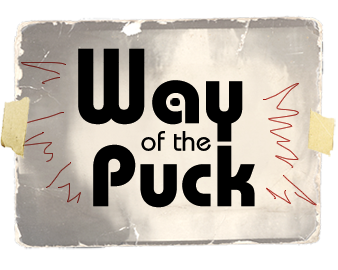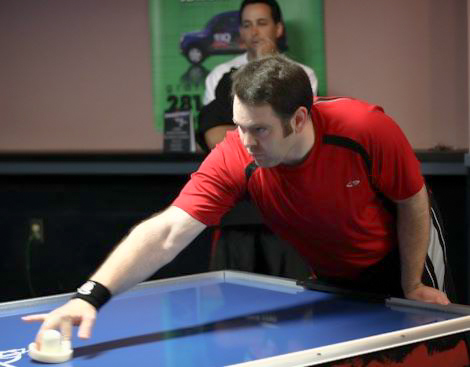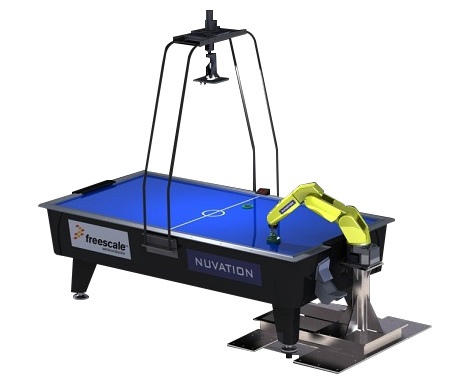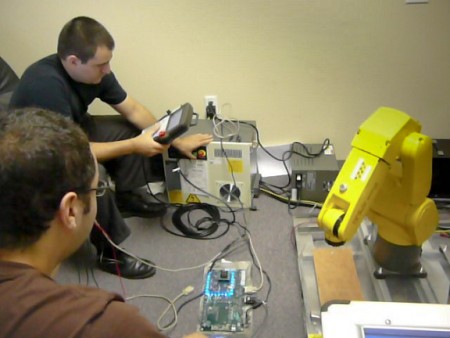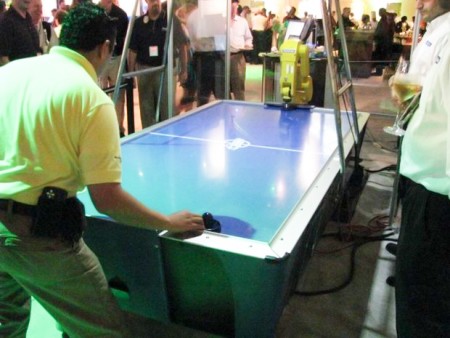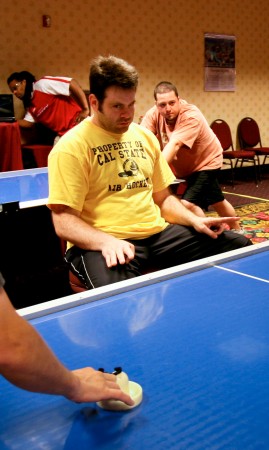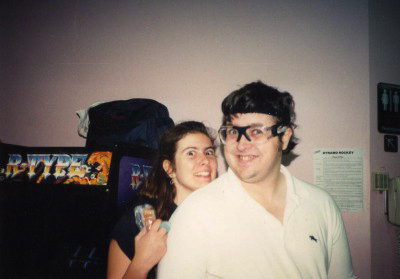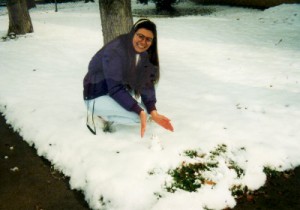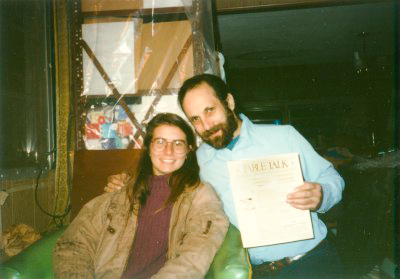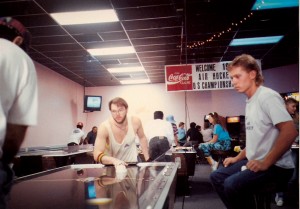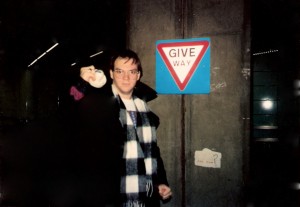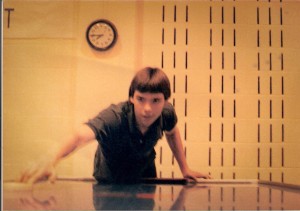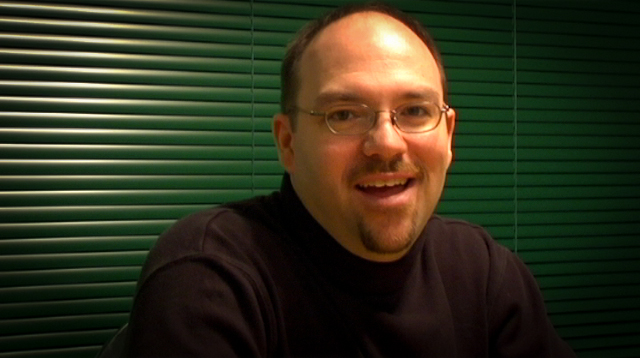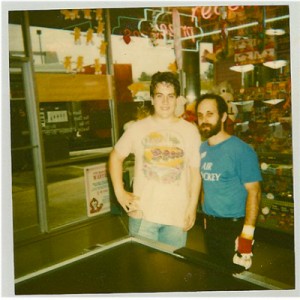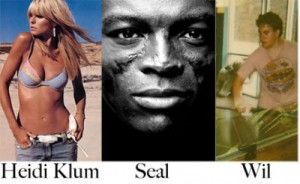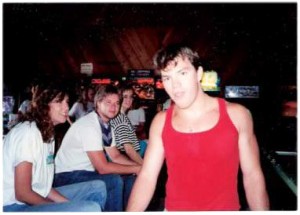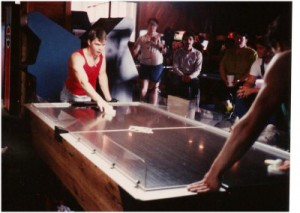Joe vs. The Volcano: Improving the Deep Blue of Air Hockey
Air hockey and robotics have a rich history. From the humanoid stylings of DB in Kyoto, Japan, to the mechanics of Professor Mark Spong’s air hockey robot at the University of Chicago, to the latest and greatest hack cobbled together with 3d printer parts, engineers find the air hockey environment to be a useful arena in which to develop autonomous robots. As a bounded, two-dimensional playing surface, with four reflecting rails and a single puck that’s batted around, the air hockey table limits the chaos coming at a newborn machine and allows it to master things like tracking, prediction, and reaction. Like many things, however, air hockey is deceptively simple to learn and punishingly difficult to master.
In 2008 game designer Joe Cain was invited to the offices of Nuvation, an engineering firm in the Bay Area, to test an air hockey robot they were developing for the Freescale Technology Forum. Cain was the number two ranked air hockey player in all of California. The following is his account of playing this robot designed to crush all humans in its path—the Deep Blue of air hockey.
By Joe Cain
Game testing is something that very naturally just comes to me; it isn’t even something I have to think about. For some reason I have an innate ability to conceptualize this stuff, like: “I see the way these dominoes are stacked up. If I do this thing that somebody’s not expecting me to do then something crazy is going to happen.”
So when I heard Nuvation was trying to find somebody who knew a little bit more about air hockey than your average engineer, I was interested. I was still working for Electronic Arts at the time and my schedule was pretty flexible so I went down to their office, which was in this weird area where San Jose and Milpitas meet up, two blocks away from an old apartment complex I used to live at. I wasn’t so sure what to expect.
I hit the buzzer and project lead, Mohan Gurunathan, took me back to a room with one or two other lab guys and said, “We really want to see if you can do some damage here to the robot. We feel like it’s pretty good but we can only do so much.” They had this robotic arm set up on the other side of an air hockey table. There was a whole apparatus up eight to nine feet above the table with a camera pointing down—it looked like an overhead, but really tall. There was a puck covered with reflective tape and there were some computers around. And on the monitors there was a representation of the table, so as the puck was being knocked around it was projecting what was going on by drawing vectors on the screen.
I kept looking at this and going, “Whoa, what’s going on here?” I wasn’t sure what they were up to exactly. I wanted to understand if this robot would react the same way a human would react or if it would do something different. I figured a straight shot probably wasn’t going to score. So I just thought, “I’ll do my normal drift, my little diagonal drift and then I’ll try to shoot a bank.”
So I drifted the puck up and almost at the centerline I punched at it with my back of the mallet and did a right-wall-under—and the arm didn’t move! The robot didn’t flinch! The puck went in and all of a sudden everybody in the room just kind of stopped—they were totally expecting the robot to block my shot. They said, “Wait, wait. Hold it. This can’t be right.” I almost felt like they were going to look and see if the arm was actually plugged in or not. Like: “Is this thing on?”
Finally, they said, “Let’s reset and do that exact same thing you just did.” So I set up, I did the exact same drift—same bank shot—and boom, I scored again. All of them were stunned and looking at each other like, “What is this guy doing?”
Well, they weren’t accounting for a drift. A lot of novice players sit behind of the puck and wiggle their hand—trying to psyche their friend out—before making a shot, and I think this is the kind of gameplay the engineers expected. They had done all of their modeling off of a stationary puck so when I drifted the puck the robot thought it was a shot. And actually, had I not redirected the puck the robot would have been in perfect position to block it—but once the robot had made a decision it couldn’t adjust. Also, the puck had to be shot at a certain speed and from a certain location; they assumed a person would probably shoot the puck from further back on the table and I was releasing much closer to the centerline.
So they made a few changes on the fly, really quickly. They moved the recognition point of a shot to further up the table and they figured out a way to determine whether something was a shot or a drift based on its speed. The robot definitely improved but it was still rough around the edges. They said, “We sort of hacked this together really fast as a result of what you just did. Give us a chance to go back to the drawing board.”
A few months later they invited me back. They were planning to put the robot in some science and tech museums around the world so they wanted to make sure it was ready. It was clear that they had isolated some weaknesses and it was actually getting difficult to score. The robot was really good at defending stationary banks and it had gotten much better at reacting to the banks when hit off a drift. But perfectly executed straight shots and chase shots still gave it problems. If I hit a Goran-style [player Goran Mitic] chase shot off-goal and then let it come back and hit my back rail before redirecting it at the opposing goal as a cross or a bank, it couldn’t stop it.
Another odd thing: Off-speed shots were also working, which I found really weird. A couple of times I hit a slow straight shot right down the middle and the robot arm actually moved completely out of the way. It didn’t know what to do. It’s as if it was thinking, “Hey, is that a shot? Is that not a shot? Where do I go?”
But by the time I went back for the third time they had really shored up a lot. Well, with the exception of a fast perfect bank, or a weird deflection, it blocked pretty much every bank, stationary or drifting. It’s pretty impressive that they were able to perfect that part of it. It was probably on the border of an expert- to pro-level defense then. I actually think this robot understood things about air hockey that many players don’t understand, especially in regards to spin. Nuvation had figured out a predictive algorithm that took spin into account and how it changed trajectory, completely without me saying anything. So that was interesting. But it still couldn’t stop a chase shot. To this day it can’t stop that. The robot just can’t handle it. The chase shot kind of blows the robot’s mind for some reason.
It can’t really play offense either, but none of these robots can. The best offense it can achieve is kind of a defensive batting back; it reads where you are going to shoot and then tries to be in that position to punch it back at you. The guys at Nuvation were experimenting with pistons—basically they chunked out a part of the front of the mallet and they inserted a piston with an air compressor. In order to shoot, it would position the mallet behind the puck and then activate the piston and then the piston would push out this piece of the mallet and shoot it forward. But even that was pretty weak.
It’s probably okay though because what I’ve often noticed is that against robots people just score on themselves! They find they can’t make an easy shot so they try to overcook something and the shot bounces back funny and they score on themselves. They probably beat themselves more than anything.
Eventually though, what you could do with this robot—if it improved enough—is program different playing styles and abilities into it. Maybe this is just the game designer in me. The robot’s behind Plexiglass so the mechanism’s protected, right? You can’t mess with it; it can’t hurt you. Then you put a video stream up and have a character of a little girl or a sumo wrestler or a ninja or a karate expert as if that’s the robot’s persona. And it’s taunting you, saying, “Hey, come on there. Try to score on me!” You could play against a super-terrible newbie with no reflexes or against the world champion Colin Cummings. Or against Colin Cummings as a 10-year old prodigy ready to kick your ass! I think somebody could pull that off—using this technology to entertain.
Either way, it’s eye opening to try to understand this puzzle Phil and Mark and Billy [players Phil Arnold, Mark Robbins, and Billy Stubbs] have been trying to deconstruct for so many years. And to watch the guys at Nuvation go through it from an engineering mindset. Air hockey is just not a perfectible thing. Even for a robot. There’s too much randomness. There are physical things that happen with a puck that you can’t predict. How many times have I tried to block a puck and I block it perfectly and it still ricochets in a weird way and scores on me anyway? No amount of raw computing power can overcome that.
Especially on a chase shot!
Editor’s note: We contacted Nuvation and learned that they were finishing up a smarter, faster, next-generation version of their air hockey robot. We tried to arrange a rematch between Joe and the robot, but the unit needed to be shipped to a science museum on the east coast. We can only speculate about its “much improved” skillsets and if it can compete with Chiba University’s robot, which is apparently intelligent enough to adjust its long-term strategy based on its opponent’s playing behavior. Maybe next time we’ll leave humans out of it altogether.
◊◊◊
My Most Memorable Air Hockey Moment: Kara (Klyn) Adema
Kara Adema (formerly Klyn) was the most dominant air hockey women’s champion in the 1990s. But she wears that crown with kind of a dubious pride, and for many years campaigned against the need for gender specific rankings. For her there was always only one true world ranking: the one that was obtained against all of the testosterone in the room. Although she has been retired from air hockey for the past decade, she was a permanent fixture during the middle third of its history.
We feel very lucky to have tracked down the legendary Kara Klyn for this article! We asked her to talk about her most memorable air hockey moment, and this is what she said:
All air hockey players remember the table that got them hooked. I was 19 and it was 1989 in a shaggy little arcade in Fremont, California called Galaxy. They had ten shiny-new Tornado foosball tables and one Dynamo brown top. I could never beat any of the guys in foosball. But on the air hockey table—that was a different story.
Somehow, a flyer for an air hockey tournament in Mountain View—about 20 miles away—made it to Galaxy. They guy behind the counter there was excited to show it to me. A few weeks later I found myself at the California State Championships with some of the best players in the world. I had no idea air hockey could be that competitive, or that amazing. That first moment seeing professional play I was so intimidated I wanted to fade into the background and just be one of the girls that just looks on. But the look on my face gave me away. I wanted to play like them. And they wanted me to learn. Even though I was thoroughly defeated in that tournament, I won friends there that I would play against, and travel, promote, and experience random adventures in life with for the next several years.
By the time the early 90s came around I was working with Mark Robbins and Tim Weissman and was fully entrenched in promoting the sport in California, and occasionally around the country. I was learning the art of organizing major tournaments and building up prizes. I loved traveling and meeting new players. I had won a couple of women’s championships at that point and while having that title was very cool, my overall ranking was for me, personally, disappointing. Even if it was considered “good” for a female player. But it so happened that my best air hockey moment happened that same year in Littleton at a Colorado state tournament.
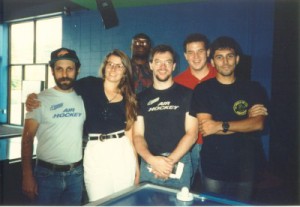
Mark Robbins, Kara, Tim Weissman, Don James, and the late Owen Giraldo. Anybody know who the guy in back is?
I was a hippy at heart then and I felt like I just fit right in with all the friendly people and the beautiful country. Being short on cash in those days I stayed with local players. I thought it was cool that the Colorado players that had been around the air hockey table a few times had a Brunswick table in their living room. Mark showed me “The Barn” filled with Brunswick tables. And by helping Mark with a few odd jobs around his place (and there are plenty of opportunities there;), one might luck out and score a Brunswick mallet, a devastating Berger puck, or some other interesting piece of air hockey history he has buried there.
But my best moment happened in a little sunken arcade within a giant indoor entertainment center. Spirits among the players was high that weekend. There was fresh snow (which was a treat for the Californians and Texans), great friends, a new laser tag gallery which we had passes to, and some truly great angles to video tape play from above the arcade pit.
While all tournaments are fun and intensely competitive, this one had a little extra undertone of fun infused in it. I went in the losers bracket my second or third match. Then something happened. I don’t know if I just stopped worrying about when I would lose and let my instincts take over, or if I found a new confidence from within. But I just kept on winning my matches. I rose above all but seven other players that weekend in the main bracket. I remember watching a video tape of that final match thinking…”Is that me playing?”
It’s been almost 20 years, since then and I think it was the highest finish ever by a woman. I didn’t even realize that at the moment. Does it still stand? I don’t know. I have won seven women’s titles against some very tough women (Andy Yevish and some others may say six titles, but that’s another story itself). But placing eighth in the main bracket was by far, my best air hockey moment.
Editor’s note: In a future installment Kara will break down her personal vendetta against the notion of holding women’s tournaments in air hockey. Looking forward to it, Kara!
Kara met her future husband Mike in 1991 and became one of the first functioning air hockey couples. They were married in 1999 and now have a beautiful daughter. Although Kara’s been out of air hockey for a while—in order to concentrate on school, career, and family—she and Mike still play each other on an old Brunswick, next to that Mustang (the other classic) in the garage.
Her portfolio and design work can be seen at: http://www.karaadema.com/
Interview with the Young Wolf: 10-Time World Champion Tim Weissman
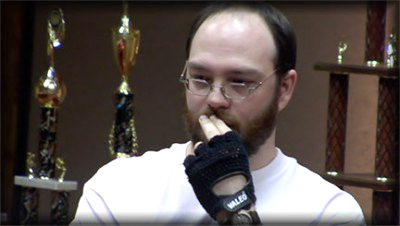
Tim “Young Wolf” Weissman
Two weeks ago two-time World Champion Wil Upchurch described a pivotal moment in his development when he was confronted by 90s pop sensation Seal and air hockey wunderkind Tim Weissman in the parking lot of a Houston gameroom in 1991. Only one person has won more air hockey World Championships than Tim Weissman—the mercurial Jesse Douty, who won eleven titles back in the air hockey Stone Age (the late 70s and early 80s). But few can dispute that Weissman took air hockey to a whole new level after dispatching Douty permanently. Weissman pioneered radical offensive and defensive playing styles that dominated competitive play from the late 80s to the mid-90s.
Many say that the best air hockey ever played was played by Tim Weissman back in the early 90s. Like many things in air hockey, of course, this claim is in dispute. But no one can argue that Weissman wasn’t the most revolutionary air hockey player of all time, when one looks at the level of play before and after his reign.
Previously, my cousin’s 11-year-old son, Henry, conducted an interview with current World Champion Davis Lee Huynh. We were delighted to hear that Henry’s interest in air hockey continues, and that he expressed a desire to ask some questions to 10-time World Champion Tim Weissman.
As before, I corrected some grammar and spelling but the questions are his. Here they are.
HENRY: Do you like Texas?
TIM: I love Texas! I’ve traveled around the country quite a bit as an adult and honestly, I have not found any other state with as much to offer. We have mountains, forests, rivers, ocean, desert, plains, large cities, small towns… It is over 700 miles from the east tip to the west tip. Plus, the American spirit is still alive and well down here. We don’t have an income tax, and the government is still friendly to business. But, above all that, we have the best air hockey players in the World. Sure, we have seen a few “decent” players come from other places, but nothing close to the amount of talent which has spawned from the Lone Star state!
HENRY: Are you the best air hockey player in history? The movie says you are.
TIM: Well, if a movie says it, it must be true. In all seriousness though, I think I am one of the best, but I can’t claim to be the best. I don’t think anyone has ever held a tighter grip during their reign than I did back in the early 1990’s. I won 9 consecutive World Championships and 28 major championships in a row over 5 years. But, I was pushing the envelope and folks had never seen many of the techniques I was using, such as the Circle Drift, quick release and the true “out” defense. Once those became part of the culture of the sport, people caught up and we have seen some phenomenal players since that time. Danny Hynes and Wil Upchurch, at their primes, were pure freaks of nature on the Table, unleashing offensive onslaughts never seen before!
HENRY: Tell me your SECRET. And don’t say “practice”.
TIM: Obsession. When I was on my 5-year winning streak, I ate, drank, slept, dreamed, imagined, thought, felt, inhaled and lived air hockey. I maintained the killer instinct in each and every tournament. When I was ahead in a game 6-1, and only needed a single point to win, I had the thought in the back of my head that I was in imminent danger of losing and had to push hard to finish my opponent off. I constantly felt that I was on the edge and could lose at any moment. It was when I started losing that edge, that hunger,the streak came to a close. I would go so far as to say that this is a good secret for any aspect of one’s life where you want to succeed or be the best. Certainly, you don’t want to lose yourself in your endeavors, but without a pure and real fire in your belly, it is hard to be great.
HENRY: Who has the craziest playing style in history?
TIM: Randy Lind, hands down. Oh, you said craziest style, not craziest person. Just kidding Randy! His style is very off-the-wall. He plays with a mallet attached to each hand, and he switches between them as he executes his attack. It can be very deceptive to newer players, but ultimately, I think when you have too much going on, you confuse yourself on a certain level. I am a big believer in keeping it simple. That’s part of what makes the Circle Drift so effective. It is very basic and simple on the surface, but from it, there derives infinite possibilities.
HENRY: Did you ever lose and feel really bad? When was that?
TIM: Every time I lose, I feel really really bad. Losing sucks. Even in my life today, I experience losses of various kinds. But, I learned some amazing life lessons from my experiences of loss in Air Hockey. First, and foremost, I learned that I hate to lose! And, that winning feels just so much better! But, more importantly, I learned that I never really understood how great it is to win until I really knew what it was like to have lost. It gave me a richer appreciation for winning, and it helped me stay humble. I also learned that losing is just a step toward winning.
When we lose, we look at what happened and analyze. We find out what contributed to that loss and how we can overcome that obstacle in the future.
HENRY: Do you make your children play air hockey? How old are they?
I have a 14-year-old boy, 10-year-old girl, 5-year-old boy and a 1-year-old boy. My children are required to play 5 hours of air hockey each and every day! Actually, the older ones play because they enjoy it. They are always begging me to practice with them. Most of the time, I am too tired from a long work day. Jacob, my oldest, won his age division at this last World Junior Championships. He is much better than I was at 14, but then again, I didn’t have a Table in my garage or a World Champion to teach me. My daughter is getting pretty good too and has a mean right-wall.
I’m glad you asked about children and air hockey though, because I do want to say that the only way I see air hockey ever growing beyond where it has been in the last 30 years is by involving children. Arcades and game rooms are pretty much a thing of the past, so where do we get our new players now? This question must be resolved for air hockey to make a leap forward. I have an answer, and I plan to try some pilot programs with the support of Mark Robbins and his new air hockey manufacturing company, Shelti, in days to come.
HENRY: How long can you hold your breath?
TIM: Funny you should ask…I actually have pretty decent lungs. I can stay underwater for around 1 min 30 seconds, give or take. One of my other interests is swimming. There is nothing more peaceful than swimming underwater across an Olympic size pool. It’s a great warm-up before a championship air hockey match!
Thanks, Tim!
Tim has a large rambunctious family and a large rambunctious array of interests. In addition to earning a Ph.D. in counseling psychology, Tim has been the owner of a special events company since 1996 and the owner of a Fish Window Cleaning franchise since 2008. His website is: http://www.fishwindowcleaning.com/619/
My Most Memorable Air Hockey Moment: Wil Upchurch, Part 1
In many ways, two-time World Champion Wil Upchurch is the perfect embodiment of all things that make air hockey players…well… air hockey players. Outsize in both personality and proportion, Wil is cheerful, raucous, intelligent, powerful, and opinionated—part gamer, part athlete, part non-conformist, and all animal when he steps up to the Table. Wil is nicknamed the Juggernaut for good reason; when he gets up to speed he is not unlike that humongous spheroid rock at the beginning of Raiders of the Lost Ark that crushes everything in its path—except he’s hairier. And sweatier.
We asked Wil to talk about his favorite air hockey moment in his long and storied career. This is what he said.
The year was 1991 and I was just a young upstart air hockey player, though one that had already achieved a fair amount of success. I lived in Dallas, Texas, where I practiced with my friends and occasionally got to test my skills against two of my air hockey heroes—Paul Marshall and Mark Robbins—the two men who had introduced me to the sport.
Being from Dallas, I lived outside the air hockey Mecca of Houston, and could only imagine going to Colorado or Philadelphia to play against the greats that resided in those places. I was on the outside, looking in. Being a teenage boy with somewhat… esoteric… tastes in hobbies and interests, I felt on the outside of pretty much everything else as well.
There was a song on the radio that summer by a new artist named Seal. It was called “Crazy,” and I didn’t care for it at all. It played over and over again on the radio as I drove down to Houston for Vince Schappell’s Houston City Classic. What I wouldn’t have given for an iPod. But I endured it, and arrived at Green’s Gameroom in Memorial City Mall ready to live up to the high expectations I had set by placing third in the Texas State Championship earlier that year. The same doubts that plague me even now crept into my mind, those that said, “they all know you’re not that good” and “they all know each other, you’re here alone.”
Crazy yellow people walking through my head… One of them’s got a gun, to shoot the other one.
Though the Old Guard had welcomed me into the sport with open arms, the young players had not been so kind. It wasn’t so much that they were cocky—boy were they cocky—but that they were close to my age, and they were better than me. And they knew it. “Green’s Wolverines,” their shirts said. Shirts that marked them as together. As something special. Their de facto leader was Tim Weissman, air hockey wunderkind, who by that time was on a winning streak of a dozen tournaments or more. He seemed untouchable, unapproachable… especially to an outsider like me.
So it was that I arrived at Green’s on Saturday morning, ready to get inside and start warming up before the tournament began. As I pulled my air hockey bag out of the car, I heard that damn song echoing across the parking lot.
No we’re never gonna survive, unless… we get a little crazy…
I turned to see who was blasting it out their open windows, and it was a little red sportscar pulling into a space right in front of the arcade. I’d had to park several rows away. The person inside the car had the gall to just sit there jamming to the song while those of us on the outside suffered. As the door started to open, I thought to myself, Oh good, it’s stopping. But in fact it kept playing, even as the driver of that sportscar, none other than Tim Weissman, emerged.
Of course, I thought. He drives a sportscar, has a hot girlfriend, wins twelve tournaments in a row, has a great group of friends that whip me on the table every time I step up, and he likes that damn song. I never felt more like Ralph Macchio than I did at that moment. At least air hockey didn’t involve getting my leg swept…
…to be continued: Can Wil defeat the Cobra Kai, or will he scurry back to Reseda? (Dallas, I mean.) And what about Elisabeth Shue?
Wil Upchurch is happily married and teaches public speaking in Ft. Wayne, Indiana.
